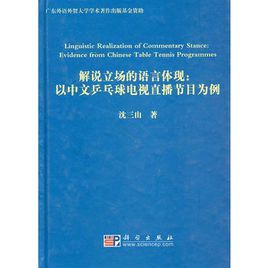內容簡介
《解說立場的語言體現:以中文桌球電視直播節目為例》收集並轉寫了從1987年到2002年桌球比賽的部分錄音錄像,這些比賽由中央電視台不同的解說員加以解說。這一研究素材涵蓋了數個國際比賽,包括十多個小時的錄音錄像,10萬餘字的轉寫材料。資料庫的性質和大小使本研究能夠對解說立場的體現形式作一個較為完整的分析研究。作為初步的研究,《解說立場的語言體現:以中文桌球電視直播節目為例》進行了兩個具有一定深度的調查。
第一個調查通過一場中外桌球選手之間的比賽,調查解說輪次的分布情況,因為解說輪次是中文桌球解說的基本語篇單位。為此,筆者專門選擇了一場比分非常接近的比賽。首先對這場比賽中比賽雙方各自的輪番技擊進行轉寫。有這一轉寫作為客觀和技術層面的參照,中文桌球現場解說中主觀和態度的層面得以統算出來。同時,藉助這一轉寫對解說輪次進行客觀的切分。其後,根據比賽中的得分和失分,檢查各個比賽輪次的解說是如何分配給比賽雙方的。這一依據擊技技術分析的客觀調查發現:在一場競賽表現非常相同的比賽中,解說輪次在中外比賽雙方的分布不是均勻的。
基於第一個調查,第二個調查通過調查言語行為在一場比賽中兩個選手之間的分布,了解中文桌球現場解說中言語行為是如何體現解說立場的。依據塞爾言語行為的執行條件以及中國人中文語感的調查,在中文桌球現場解說中發現並定義了八種常用的言語行為。它們分別是“叫好、嘆惜、表揚、批評、建議、擔憂、找理由和期待”。調查素材加註上述言語行為後進行計算處理,以便觀察言語行為在中外球手之間有無分布差異。結果發現,分布的差異具有統計上的顯著意義。
目錄
Acknowledgements
前言
Abstract
Chapter1Introduction
1.1TheObjectofResearch
1.2ChineseTableTennisCommentary
1.3StanceinChineseTableTennisCommentary
1.4GeneralApproach
1.5OrganizationoftheBook
Chapter2LiteratureReview
2.1Introduction
2.2SportsAnnouncerTalk
2.2.1SATasaregisterorgenre
2.2.2LinguisticfeaturesofSAT
2.2.3KeyinformationtiersinaSAT
2.2.4MethodologyinSATresearch
2.2.5ProfessionalexperienceinproducingaSAT
2.2.6SummaryonthereviewofpreviousSATresearches
2.3LinguisticTheoryofEvaluation
2.3.1Affectioninlexis
2.3.2Stanceinsentence
2.3.3Evaluationindiscourse
2.4SpeechActTheory
2.4.1WhySpeechActTheory?
2.4.2AbriefintroductiontoSpeechActTheory
2.4.3Whatotherspeechactdoesaconstativeutteranceusuallyperform?
2.4.4Isthereanalternativewaytoclassifyspeechacts?
2.4.5Whatistherelationshipbetweenandamongspeechacts?
2.4.6SummaryonthereviewofSpeechActTheory
2.5DiscussionandSummary
2.5.1Discussion
2.5.2Summary
Chapter3ResearchMethodology
3.1GeneralHypothesis
3.2DataCollection,TranscriptionandProcess
3.2.1Dataselection
3.2.2Datatranscription
3.2.3Dataprocessing
3.3CompetitioninTableTennisandComparisoninCITC
3.3.1AspectsofCTFC:objectiveorsubjective
3.3.2Comparativecategories
3.4TwoKeyComparisons
3.4.1Selectionofpoint,stroke,orperformanceforevaluation
3.4.2Speechactallocationandanalysis
3.4.3Evaluationpatternsandtheirallocation
3.5DiscussionandSummary
3.5.1Discussion
3.5.2Summary
Chapter4AGeneralDescriptionofCTTC
4.1Introduction
4.2GeneralDescriptionofCTTC
4.3BasicStatistics
4.3.1Constantfrequencyofdifferentcommentaries
4.3.2Discourseusagesandpatterns
4.4GeneralStructureofaCT]?C
4.4.1Informationtiers
4.4.2Evaluationdistribution
4.5DiscussionandSummary
4.5.1Discussion
4.5.2Summary
Chapter5SelectionofPointsandStrokesforCommentary
5.1Introduction
5.2BasicConcepts
5.2.1Basicsoftabletennisstroke
5.2.2Alternatestrokes
5.2.3Pilottranscriptionofalternatestrokesbytheauthor
5.2.4Transcriptionofalternatestrokesbycoaches
5.2.5Generalsummary
5.3CompetitionPointandCommentaryUnit
5.3.1Scorereportsandgamestages
5.3.2Commentaryunit
5.3.3Stagecontentsandtheirorganization
5.4StagePerspectiveandCommentaryStance
5.4.1Basicperspectives
5.4.2Stageperspective
5.4.3Commentarydistribution
5.4.4Commentarystance
5.5SummaryandDiscussion
5.5.1Summary
5.5.2Discussion
Chapter6CategoryandDistributionofSpeechActs
6.1Introduction
6.2commentator,AudienceandPlayerinaCTTC
6.3SpeechActsinaCTTC
6.3.1Definitionandcategory
6.3.2Speechacttagging
6.4DistributionofSpeechActsinaCTTC
6.5MacroSpeechAct
6.6SummaryandDiscussion
6.6.1Summary
6.6.2Discussion
Chapter7Conclusion
7.1MajorFindingsandContributions
7.2Conclusions
7.3LimitationsandFurtherStudies
7.3.1Limitations
7.3.2Furtherstudies
References
Appendix1DetailsoftheResearchData
Appendix2GlossaryofTableTennis
Appendix3ASampleCTTC
Appendix4EnglishTranslationoftheSampleCTTC
Appendix5AlternateStrokesTranscription
Appendix6IntuitionConsultation
Appendix7StatisticsofSpeechActAllocation

